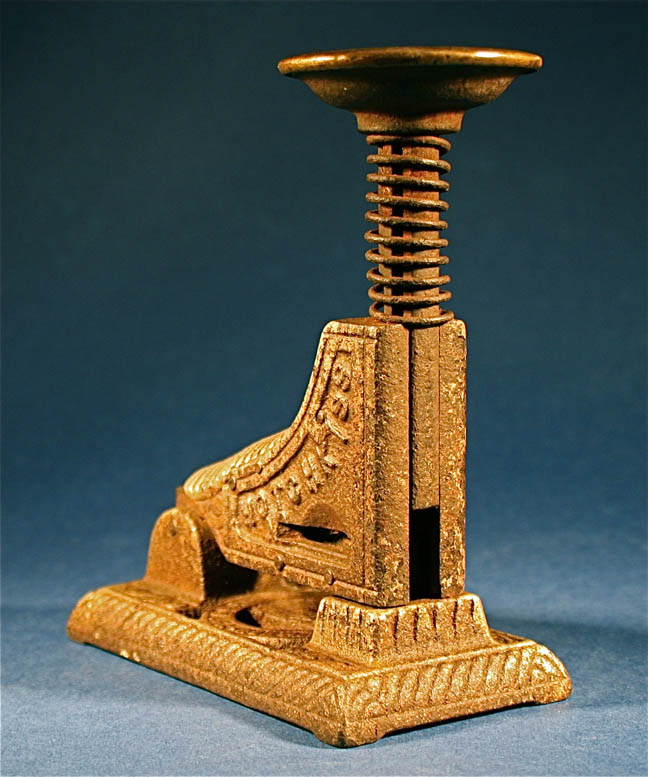
Title: Antique Industrial Hotchkiss Victorian Stapler Fastener Tool
Catalog Number: 4925
Category: Metals / Machine
Artist:
Country & Origin:
Historical Period: 19th Century
Approximate Date: 1890s to 1930s
Signature: Unsigned
Condition: Museum Quality
Size:
Height: 4 1/2
Width: 4
Depth: 2
Weight:
Description & Provenance: Magnificent Victorian Stapler Tool. Made by Hotchkiss of Norwalk Conn., the oldest and largest manufacturer of stapling machines and staples. This is a nice example of an 1890s Victorian stapler. Made U.S.A. The invention is to effect the insertion and clinching of a staple in sheets of paper, pamphlets, or other articles. The Hotchkiss: Probably in greater demand today than any other stapler is the Hotchkiss. These early machines are beautifully built and have the Victorian design about them that just says, "Antique". This model used what was known as the Herringbone stapler. It took a strong fist to strick the head of the stapler to separate the staple from the strip. To support an extra long strip of staples, this early example has a long curved tail on it. While some collectors have indicated that the original design was attributed to James Keyes' patent number 572,346 a close examination clearly credits his patent as an improvement to the stapling machine patented by Edwin T. Greenfield. Patent 572,293 is in fact the true patent for the invention of this machine. Many collectors believe that all Hotchkiss Fasteners came with this tail, but in fact, they did not. Hotchkiss had a great deal of success and commanded its fair share of the market up until the 1930's. By that time others decided to share in the profits to be made by this little office giant. Imposing appearances and novel designs are always preferred to collectors. I wish you all well and may that never ending search lead you to a very rare find at a really great price.
Origin, Encyclopedia & Researched Articles:
Encyclopedia Name: http://en.wikipedia.org/wiki/Stapler
The first known stapler was handmade in the 18th century in France for King Louis XV. Each staple was inscribed with the insignia of the royal court, as required. The growing uses of paper in the 19th century created a demand for an efficient paper fastener.
McGill stapler
In 1866, George McGill received U.S. patent 56,587 for a small, bendable brass paper fastener that was a precursor to the modern staple. In 1867, he received U.S. patent 67,665 for a press to insert the fastener into paper. He showed his invention at the 1876 Centennial Exhibition in Philadelphia, Pennsylvania, and continued to work on these and other various paper fasteners through the 1880s. In 1868 a patent was also taken out for a stapler in England by C.H.Gould. As well, also in 1868, Albert Kletzker of St Louis, MO patented a device to staple paper.
In 1877 Henry R. Heyl filed patent number 195603 for the first machines to both insert and clinch a staple in one step, and for this reason some consider him the inventor of the modern stapler. In 1876 and 1877 Heyl also filed patents for the Novelty Paper Box Manufacturing Co of Philadelphia,PA, However, the N. P. B. Manufacturing Co.'s inventions were to be used to staple boxes and books.
The first machine to hold a magazine of many preformed staples came out in 1878.
On February 18, 1879, George McGill received patent 212,316 for the McGill Single-Stroke Staple Press, the first commercially successful stapler. This device weighed over two and a half pounds and loaded a single 1/2 inch wide wire staple, which it could drive through several sheets of paper.
The first published use of the word "stapler" to indicate a machine for fastening papers with a thin metal wire was in an advertisement in the American Munsey's Magazine in 1901.
In the early 1900s, several devices were developed and patented that punched and folded papers to attach them to each other without a metallic clip. The Clipless Stand Machine (made in North Berwick) sold from 1909 into the 1920s. It cut a tongue in the paper that it folded back and tucked in. Bump's New Model Paper Fastener used a similar cutting and weaving technology.
In 1941 the type of paper stapler that is the most common in use today was developed: the four way paper stapler. With the four way, the operator could either use the stapler to staple papers to wood or card board, or used to staple like pliers for bags, or the normal way with two options, one the standard with the staples going inward or turning the plate and the staples going outward.
Verbal History:
A stapler is a mechanical device that joins sheets of paper or similar material by driving a thin metal staple through the sheets and folding the ends. Staplers are widely used in government, business, offices, and schools.
The word "stapler" can actually refer to a number of different devices of varying uses. In addition to joining paper sheets together, staplers can also be used in a surgical setting to join tissue together with surgical staples to close a surgical wound (much in the same way as stitches or sutures).
Typically, most staplers are used to join multiple sheets of paper. Paper staplers come in two distinct types: manual and electric. Manual staplers are normally hand-held, although models that are used while set on a desk or other surface are not uncommon. Electric staplers exist in a variety of different designs and models. Their primary operating function is to join large amounts of paper sheets together in rapid succession. Some electric staplers can join up to 20 sheets at a time.














Comments are subject to review
Be the first to comment!